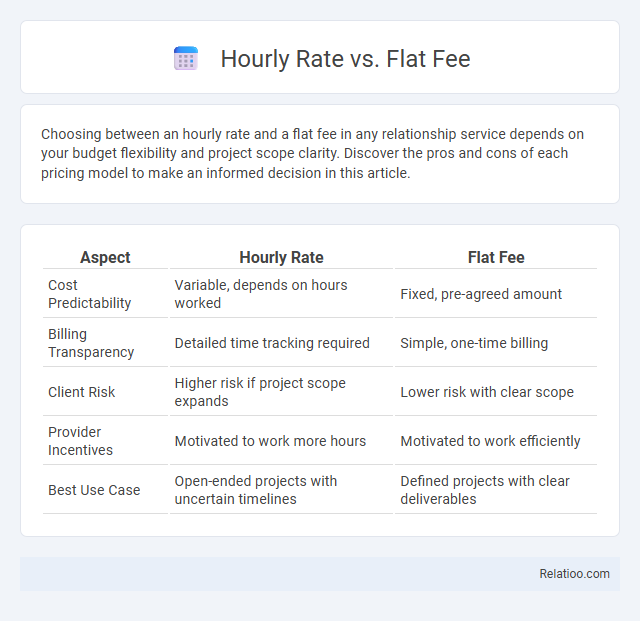Choosing between an hourly rate and a flat fee in any relationship service depends on your budget flexibility and project scope clarity. Discover the pros and cons of each pricing model to make an informed decision in this article.
Table of Comparison
| Aspect | Hourly Rate | Flat Fee |
|---|---|---|
| Cost Predictability | Variable, depends on hours worked | Fixed, pre-agreed amount |
| Billing Transparency | Detailed time tracking required | Simple, one-time billing |
| Client Risk | Higher risk if project scope expands | Lower risk with clear scope |
| Provider Incentives | Motivated to work more hours | Motivated to work efficiently |
| Best Use Case | Open-ended projects with uncertain timelines | Defined projects with clear deliverables |
Understanding Hourly Rates
Understanding hourly rates involves recognizing it as a flexible payment method where You are charged based on the exact time spent on a task or project, measured in hours. This model provides transparency and control over costs, making it ideal for projects with unpredictable durations or evolving scopes. Hourly rates often vary by industry, expertise level, and geographic location, emphasizing the importance of comparing rates to ensure fair compensation.
What Is a Flat Fee?
A flat fee is a fixed price agreed upon for a specific service regardless of the time spent or effort required, providing clarity and predictability for both parties. This pricing model contrasts with hourly rates, which charge based on the time invested, and chore compensation, often used in informal or household settings to reward task completion. Choosing a flat fee simplifies budgeting and helps avoid disputes over billing hours or task complexity.
Key Differences Between Hourly and Flat Fee Pricing
Hourly rate pricing charges you based on the exact time spent on a task, offering flexibility but potential cost variability. Flat fee pricing involves a predetermined total cost regardless of hours worked, providing budget predictability but less adaptability to project changes. Understanding these key differences helps you choose the most suitable compensation method for your service needs.
Pros of Charging Hourly Rates
Charging hourly rates allows you to be fairly compensated for the exact time and effort invested in a project, ensuring no work goes unpaid. This pricing method offers flexibility to adjust for changes in project scope, reducing the risk of undercharging. Clients often appreciate the transparency and accuracy of hourly billing, fostering trust and clear communication.
Advantages of Flat Fee Billing
Flat fee billing offers predictable costs for clients, eliminating surprises associated with hourly rate fluctuations. It simplifies budgeting by providing a fixed price upfront, enhancing transparency and trust between service providers and clients. This method incentivizes efficiency, as businesses can complete tasks without the pressure of tracking billable hours.
Drawbacks of Hourly Rate Models
Hourly rate models often lead to unpredictable costs and budgeting difficulties for clients due to fluctuating work hours. This pricing structure can incentivize inefficiency, as service providers might extend time spent on tasks to increase earnings. Moreover, lack of a clear project scope under hourly billing complicates performance evaluation and cost control.
Disadvantages of Flat Fee Structures
Flat fee structures can lead to underpayment for your work if the project scope expands beyond initial estimates, as the fixed amount does not account for additional time or effort. This model often results in ambiguous boundaries, causing disputes over what tasks are included, which may compromise the quality of deliverables. In contrast to hourly rates, flat fees lack flexibility, potentially discouraging thorough, high-quality work on complex or evolving projects.
When to Choose Hourly Rate Over Flat Fee
Choose an hourly rate when project scope is uncertain or tasks require frequent adjustments, ensuring fair compensation for variable time investments. Hourly rates provide flexibility for services like consulting, legal advice, or custom design work where deliverables and timelines may shift. This model protects both client and provider from scope creep and unforeseen complexities, unlike flat fees that assume fixed, well-defined workloads.
Industries Best Suited for Each Pricing Method
Freelance creative industries such as graphic design and content writing often favor hourly rates for precise project tracking and flexible client engagement. Flat fees suit well-defined projects typical in web development and legal services, offering clear budgeting and scope management. Chore compensation methods align best with gig economy roles like delivery services and domestic work, incentivizing task completion and efficiency.
Making the Right Pricing Decision for Your Business
Choosing between hourly rate, flat fee, and chore compensation depends on your business model, project complexity, and client expectations. Hourly rates provide flexibility and transparency, flat fees offer predictability for fixed-scope tasks, and chore compensation suits repetitive or task-specific jobs. Understanding these pricing strategies helps you maximize profitability while aligning with your clients' needs.

Infographic: Hourly Rate vs Flat Fee
 relatioo.com
relatioo.com